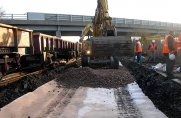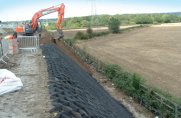- Market Sector
- Application Function
- Products
- Geotextiles
- Geocomposites
- Geocomposite Drains

Geocomposite Drains
Terram geocomposite drains are designed to replace 'traditional' solutions and are highly effective in the collection and conveyance of both liquids and gases. - Salt Barrier Geocomposite

Salt Barrier geocomposite
Developed to prevent damage caused by the capillary rise of saline groundwater into 'sweet' soil zones. - Frost Blanket Geocomposite

Frost Blanket
A purpose-designed, protection geo-composite for mitigating the effects of frost heave. - PW2 (Railway Track-bed Drains)

PW2 trackbed robust separator
A robust separator / filter incorporating a stiff net between two textile filter layers.
- Geocomposite Drains
- Geocells
- Erosion Control

Erosion Control Geocell
Terram geocell is a relatively shallow cellular confinement system which is used to combat erosion on slopes up to 1:1. - Retaining Wall

Soil Structure Geocell
Terram Series 500 Geocell provides a cost-effective alternative to conventional earth retention structures. - Tree Root Protection / Load Platform Geocell

Tree Root Protection Geocell
Terram geocell is a cellular confinement system that is used to protect tree roots from damage caused by heavy vehicles.
- Erosion Control
- Geonets
- Landscape Fabrics
- Consumer / DIY
- Downloads
- About Us
- Contact Us
A geosynthetic provides one or more of four functions when used in track-bed construction: Separation to maintain the integrity of adjacent soil types i.e. prevent intermixing. Filtration to prevent leaching of soil particles. Drainage to allow the free passage of water. Reinforcement to provide additional strength.
Controlling erosion on railway slopes
Products
Application Function
Controlling erosion on railway slopes
Once installed, a TERRAM Geocell provides immediate stability by confining the fill and greatly improves resistance to wind and run-off.
With a topsoil fill, the stability is further enhanced as vegetation becomes established and a geocell can be used to establish vegetation on slopes where establishing cover would otherwise have been a problem. The honeycomb of cells provides protection for the vegetation during the early, sensitive period of germination and growth.
The Geocells are formed from TERRAM Geotextile to confine the fill and the permeable walls allow drainage from cell to cell down the slope. Other geocells achieve this cell-to-cell drainage by perforating the walls but this process can lead to weaknesses. Geocells fabricated from impermeable materials suffer from weiring - water cascading down the slope from cell to cell – and this causes ongoing loss of soil from the cells.
Many variables affect the installation and performance of a slope-protection geocell, including slope angle, slope stability, the infill type, rainfall levels and irrigation (if included). It is important therefore that due consideration is given to all relevant criteria on a project by project basis.
Typical applications include:
• Cuttings and embankments
• Noise-deflection and environmental bunds
• Abutments
• Steepened slopes
• Soil nailing cover
• Drainage ditches




















